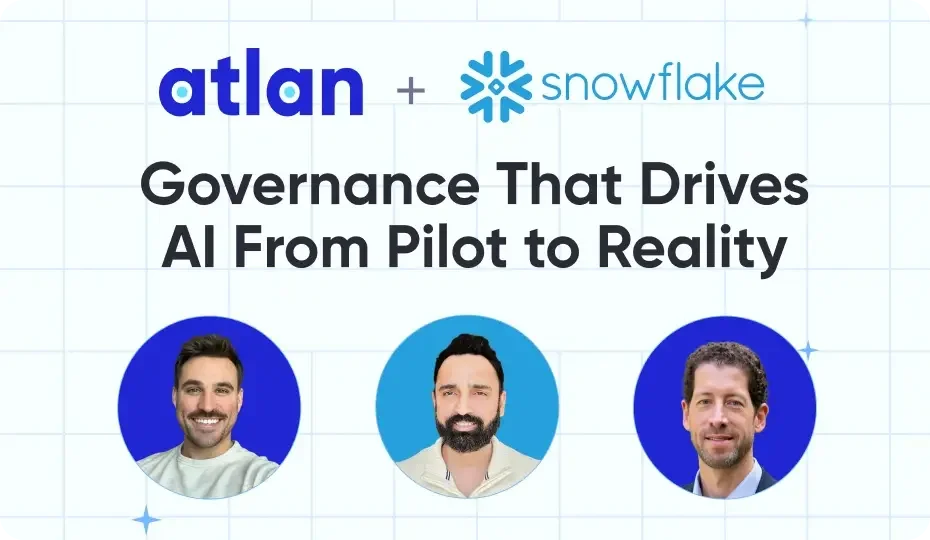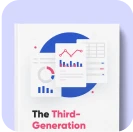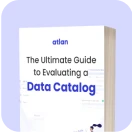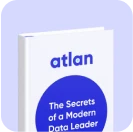Top Takeaways From Gartner D&A Summit 2025: Embracing the Uncertain Future of Data Governance and AI
Share this article
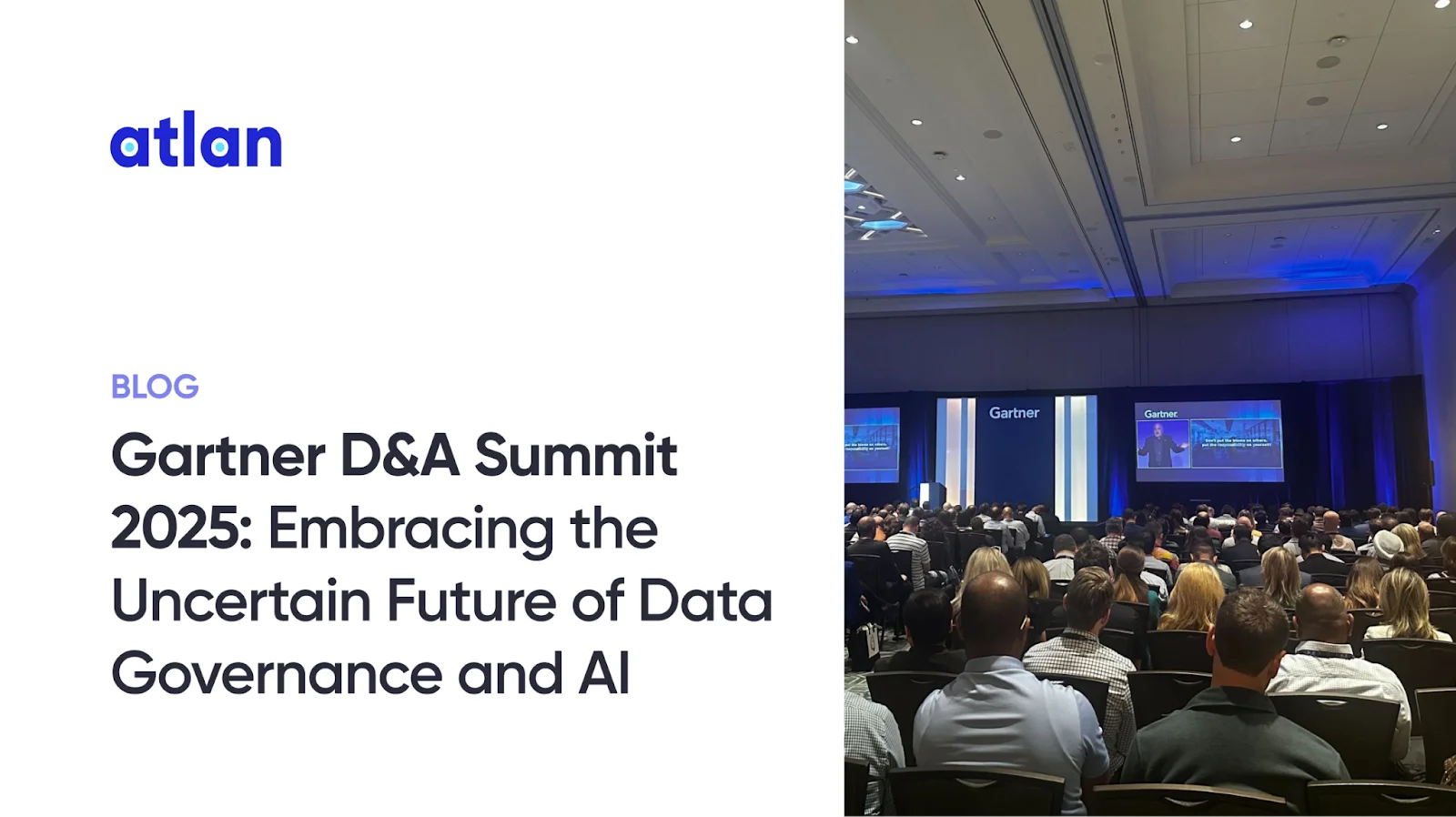
If you work in data, you already know—the Gartner Data & Analytics Summit is where the world’s top data leaders, analysts, and practitioners gather to discuss what’s next for data, AI, and analytics. And if there’s one key takeaway from Gartner D&A Summit 2025, it’s this: the AI revolution has fundamentally changed what it means to be "data-driven." From how we think about governance to how we measure data quality, everything is being reimagined through the lens of AI.
At Atlan, we live and breathe this change. We’ve spent years working with data teams across industries, helping them move beyond legacy governance and towards a more collaborative, AI-ready way of working with data.
The release of Gartner’s inaugural Magic Quadrant for Data & Analytics Governance Platforms marks an exciting milestone. After countless conversations with data leaders, it’s validating to see the industry recognize that governance has evolved from a compliance checkbox to an innovation enabler. Atlan’s recognition as a Visionary affirms our belief in reimagining governance for the AI era.
We spent the last few days deep in discussions with data leaders, sitting in on insightful sessions, and hosting conversations about the future of data governance and the role of active metadata. Through all of this, a few major themes kept coming up—ideas that aren’t just shaping the industry, but also defining Atlan’s vision for what comes next.
In this post, we’ll break down the key takeaways from the Gartner Data & Analytics Summit 2025, unpack insights from the most thought-provoking sessions, and explore what these shifts mean for the future of data teams. Let’s dive in.
- “AI is the cake, governance is the salad” - Why governance is now mission-critical
- From data quality to data readiness: The paradigm shift redefining success
- Active metadata: The foundation of the AI trust stack
- Best-of-breed wins in the AI era
- Minimum viable governance is replacing command-and-control approaches
- Change management makes or breaks data initiatives
- What this means for your data strategy
- Our commitment moving forward
“AI is the cake, governance is the salad” - Why governance is now mission-critical #
One of the most memorable quotes from the keynote perfectly captured the relationship between AI and governance: “AI is the cake, governance is the salad.” This isn’t just clever wordplay. Gartner’s research backs governance as essential: “by 2027, 60% of organizations will fail to realize the anticipated value from their AI investments due to incohesive governance frameworks.” When we talked to data leaders at the conference, they confirmed this reality. AI without governance is like building on quicksand.
We were particularly struck by real-world examples shared during the “Technical Insights: A Technical View of AI Governance” session by Gartner Analyst Sumit Agarwal:
- The launch of Apple/Mastercard in 2019: Within 4 months of launch in August, the card was accused of gender bias in its MLOps model, causing significant reputational damage. The New York DFS investigation found that while it was legally compliant and considered spouse applications separately, it failed to communicate the logic to users. As noted in the presentation, “Even though the AI model was good, [they] were missing basic AI governance best practices” including transparency and clear reporting of metrics.
- The Mata vs. Avianca lawsuit: Attorneys used ChatGPT for legal research but the AI failed to find relevant case information, leading to citations of non-existent legal precedents. This highlighted the unreliability of AI outputs without proper governance controls.
The message was clear: no matter how sophisticated your AI models are, they’re only as good as the governance foundation supporting them.
From data quality to data readiness: The paradigm shift redefining success #
If there was one phrase that kept coming up in nearly every session, it was “data readiness.” This represents a massive shift in how we think about data quality—and it’s one we’ve been advocating for at Atlan.
At the keynote, we heard: “I’d rather have a worn-out map of the right place versus a pristine copy of the wrong map.” Traditional data quality metrics fail to scope and align quality to business value. Data’s value now depends on whether it’s fit for purpose and matched to the required quality in specific AI/ML contexts.
The summit showed that while “77% of organizations rank AI-ready data initiatives as their top investment priority, only 43% self-assess as having AI-ready data.” (2024 Gartner Evolution of Data Management Survey)—a massive gap between ambition and reality.
What does “data readiness” mean in practice?:
- Context over perfection: “Building data quality without context is a bad habit we have to break”
- Lineage and traceability: “68% of organizations evaluate lineage for AI readiness”
- Diversity of data sources: “Yet only 30% evaluate data diversity for AI use cases”
At Atlan, we’ve been preparing for exactly this shift—moving from static data quality metrics to a holistic approach that considers context, use cases, and trust signals from across the data ecosystem.
Active metadata: The foundation of the AI trust stack #
If data readiness is the goal, active metadata is the engine that powers it.
The numbers tell a stark story: Gartner Analyst Ehtisham Zaidi shared from the 2024 Gartner Evolution of Data Management Survey that “51% of organizations still have only early-stage metadata practices based on manual inventories, and only 23% use machine learning for metadata analysis and recommendations”. The vast majority are missing out on what Gartner calls “active metadata”—where metadata isn’t just collected but analyzed and activated to drive automation and insights.
This gap represents a massive opportunity. The “Unstructured Data Quality: How to Improve Trust to Ensure AI-Ready Data” session by Gartner Sr Director Melody Chien described metadata as the crucial matchmaker that facilitates the match between questions and unstructured data. Without sufficient metadata, you end up with “mis-matching and mis-answering”—precisely the hallucination problems plaguing many early AI implementations.
Key points:
- Metadata is the foundation for moving “from just a tech stack to a trust stack”
- “46% of organizations are prioritizing active metadata tools for investment in the next 2-3 years”
- “Knowledge graphs will be leveraged by over 40% of LLMs by 2026, providing the semantic context essential for AI accuracy”
At Atlan, our metadata-first approach has always been built around these principles. Our platform isn’t just collecting metadata—it’s actively analyzing it, surfacing insights, and using it to power automation that makes data teams more productive.
Best-of-breed wins in the AI era #
One of the most validating moments of the summit for our team was hearing Gartner analysts advocate for modular, best-of-breed approaches to data architecture. As one keynote speaker put it: “Going to a single vendor for all your needs is like going to the same supermarket for everything, but best of breed is like going to boutique stores that are suited for various needs.”
This is exactly what we’ve been saying for years with our metadata control plane approach. The consensus at the summit was clear:
- Technology is changing faster in the AI era than ever before
- Diversity and variety in the data ecosystem are more prevalent than ever
- Modular architectures help teams prepare for change
This is why we’ve built Atlan as an open platform that connects to your entire data stack, rather than trying to replace it. Our philosophy has always been to enhance and integrate with your existing tools, not force you to migrate and replace them.
Minimum viable governance is replacing command-and-control approaches #
Another fascinating trend we observed was the shift toward what Mark Beyer and Andrew White called “minimum viable governance” in their “D&A Governance vs Data Management Debate” session. The old approach of controlling everything is giving way to more focused, purpose-driven governance:
- “The minimum number of controls for things to run smoothly”
- “Minimum data quality fit for purpose, because anything above that is wasted effort”
“By 2027, 40% of Chief Data and Analytics Officers will have rebranded governance as ‘business enablement of strategic business initiatives’ rather than a control function.” "Predicts 2024: Data and Analytics Governance Requires a Reset", Gartner report
The most successful organizations are using trust models with graduated levels from “Unknown” to “Assured,” rather than binary governed/ungoverned approaches.
This shift toward more focused, purpose-driven governance was illustrated during our joint customer Gartner session “How General Motors and Atlan Operationalize Data Governance in the AI Era.” Pedro Martinez, Lead Data Governance Manager at GM, shared how they’ve moved away from centralized, IT-driven governance that “gets pushed from the top” toward a more decentralized approach embedded in their culture.
“Decentralizing is needed,” Martinez explained. “This IT centralized data governance that gets pushed from the top, it’s not fast enough for us to solve their problems. It’s not agile, it reduces the time for innovation.”
GM’s approach embodies the minimum viable governance principle by “shifting left” to embed governance proactively in the development lifecycle through defined checkpoints. Rather than treating governance as an afterthought, their teams establish governance expectations before development begins, incorporate governance requirements into test cases, and implement a certification process that balances automation with necessary human oversight. This approach ensures governance supports, rather than hinders, GM’s ambitious goals around zero crashes, zero emissions, and zero congestion.
This aligns perfectly with our philosophy at Atlan. We’ve always believed that governance should be embedded in workflows, not imposed from above. It should accelerate work, not slow it down. And it should focus on enabling teams to get more value from data, not just preventing misuse.
Change management makes or breaks data initiatives #
Technology is only part of the equation. Multiple sessions highlighted that the biggest reason data projects fail isn’t the tech—it’s people and change management.
As Michael Tantrum bluntly stated in his “Coalesce: Bringing Order to Chaos: How to Succeed in a Data and Analytics World” session: “Over 100s of data projects, I have seen change management is the biggest reason for failure.” Successful organizations, like Takeda, are creating dedicated “value creation offices” to demonstrate tangible benefits from data initiatives.
According to the “2024 Gartner Data & Analytics Governance Survey” cited by Ehtisham Zaidi and Mark Beyer in their “End the Data Fabric/Mesh Debate” session, 69% of organizations are committing significant resources to strengthen partnerships between their data and analytics functions and business units. This focus on organizational alignment is essential for success.
The critical importance of organizational alignment was clear during our joint customer Gartner session “How Medtronic Built a D&A Governance Operating Model to Deliver Trusted Data.” Deytr Francisco shared how Medtronic transformed from a static catalog with minimal adoption to a dynamic governance approach that drove significant business impact.
The foundation of their success? A clear organizational structure starting with the Medtronic Data Analytics Council at the executive level, which established governance as a core pillar of their strategy. This top-level commitment cascaded through a well-defined hierarchy of domain sponsors, domain owners, data owners, and stewards—creating clear accountability and alignment across the organization.
Medtronic also took a distinctly user-centric approach to their technology selection. Francisco shared that by involving enterprise architecture, global supply chain, and security and privacy teams in their platform evaluation, they ensured their solution would address diverse needs rather than just technical requirements.
The results speak for themselves: within six months of implementing their new governance approach with Atlan, user adoption surpassed what they had achieved in four years with their previous solution. Medtronic’s journey demonstrates that technology alone isn’t enough—organizational alignment and change management are essential ingredients for governance success.
At Atlan, we’ve always emphasized the collaborative aspects of data work. Our platform is designed not just for data engineers or analysts, but for entire cross-functional teams to collaborate around data. Features like data products, policy center, and cross-platform embedding are all built to foster this collaboration.
What this means for your data strategy #
After absorbing all these insights, what should data leaders take away? Here are our key recommendations based on what we learned:
- Embrace “data readiness” over abstract quality metrics: Focus on fit for purpose in AI initiatives, not just traditional data quality measures
- Make active metadata your foundation: It’s not enough to catalog your data; you need to activate metadata to drive insights and automation
- Adopt modular, best-of-breed architectures: Flexibility and interoperability are more important than ever in the AI landscape because they enable organizations to quickly adapt to new technologies, prevent vendor lock-in, and optimize for specialized capabilities as AI tools and techniques continue to advance at an unprecedented pace
- Transform governance from a control function to a business enabler: Focus on minimum viable governance that accelerates rather than impedes work
- Invest in change management and organizational alignment: Technology alone won’t drive success; you need to bring people along on the journey
- Create data strategies that start with business outcomes: Work backward from desired outcomes to capabilities, not the other way around

Our commitment moving forward #
The Gartner Summit reinforced what we’ve been building at Atlan: a collaborative, metadata-driven approach to data & AI governance that enables teams to deliver more value, faster.
As we continue to develop our platform, we’re doubling down on:
- Active metadata capabilities that help you understand and leverage your data estate
- Collaborative governance features that enable teams to work together more effectively
- AI-ready data assessments that help you understand where you stand and what to improve
- Integration with your entire data stack through our open, best-of-breed approach
Webinar: Gartner D&A Summit: Key Takeaways #
The Gartner D&A Summit 2025 was jam-packed with insights, but one can’t have caught every session. Our team has got you covered.
In this webinar, Austin Kronz, Atlan, Director of Data Strategy and former Gartner analyst, will break down the must-know highlights you shouldn’t miss. Join us to dive deeper into the trends shaping the future of data and learn how you can put these insights into action. Register now to save your spot!
Top Takeaways From Gartner Data & Analytics Summit 2025: Related reads #
- Gartner Data & Analytics Summit 2025: Theme, Tracks, FAQs
- Gartner Data Catalog Research Guide
- Gartner Active Metadata Management
- Gartner on Data Mesh
- Gartner on Data Fabric
- Gartner on Data Lineage
- Gartner on DataOps
- Gartner Magic Quadrant for Metadata Management
- Gartner Magic Quadrant for Data Quality
Share this article

